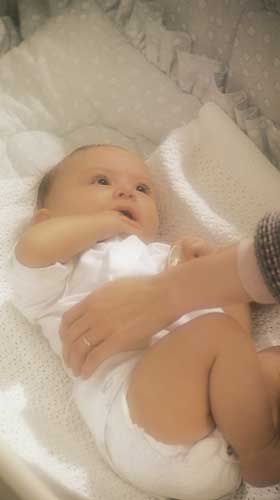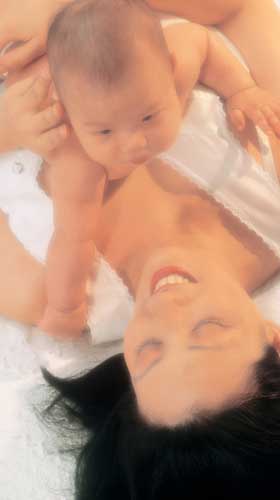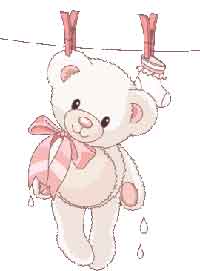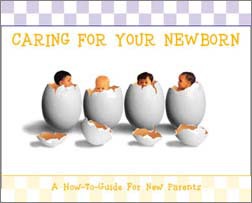 Preventing Infection
Preventing Infection
Any type of infection can be very serious for a newborn. For the first few weeks, your baby’s umbilical cord needs special care to keep it from getting infected. If your baby boy has been circumcised, his penis also needs to be protected from infection. Washing your hands every time you touch your baby will help guard against infection. The most important thing you can do to protect your newborn from infection is to wash your hands, before and after you handle your baby. (See tips on proper handwashing.)
Umbilical cord care
While in the womb, your baby gets everything he needs to live and grow through the umbilical cord. At birth this cord is clamped-off close to his body and cut. It does not hurt your baby when the cord is cut. Once the cord is cut, it leaves an “umbilical cord stump”. The stump will wither and turn black within 2 to 3 days. Within 10 to 21 days the stump will dry up and fall off, leaving a raw spot that takes a few days to heal. It does not hurt your baby when the stump falls off. If the stump has not fallen off by the time your baby is 2 months old, take your baby to the pediatrician.
To help the stump dry out and fall off, keep the stump uncovered by folding the diaper below the umbilical cord stump. Folding down his diaper keeps urine from getting on the stump and exposes it to air. Until the stump falls off and the raw spot heals, clean the base of the stump with a cotton tipped swab and rubbing alcohol each time you change his diaper and at bath time. Dip the cotton swab in alcohol and clean at the base where the stump meets the skin. If your baby jumps when the alcohol touches the stump or skin, it’s because the alcohol is cold, not because it stings. The alcohol doesn’t sting because there are no nerves in the stump. Instead of a tub bath, give your baby a sponge bath until the stump falls off and the navel area has completely healed.
The stump and the skin around the stump should be checked every day for redness, odor, or discharge. A small amount of bleeding is normal when the stump begins to fall off. Do not pull off the stump, or try to loosen it, even if it looks like it is hanging by a thread. If the navel area at the base of the cord becomes red or swollen, is filled with pus, or covered with pustules, or your baby cries when you touch the cord or the skin around it call your pediatrician. If you notice a bad smell or the stump is bleeding, call your pediatrician right away. Pustules look like pimples or blisters and could mean the stump is infected and needs antibiotic treatment.
Sometimes the cord doesn’t completely dry up but forms a small reddish scar that drains a light-yellow fluid. This condition usually goes away within a week, but if it doesn’t call your pediatrician and ask if you need to bring your baby in to the office.
If the skin around the umbilical cord pushes outward when he dries, he may have a hernia. This is not serious and will likely heal in 12-18 months. You do not need to do anything to the area.
Nail care
Trim your baby’s fingernails a few days after birth to prevent him from scratching his face or eyes. Trim off the rough edges so that the nails are straight across and keep them short so he cannot scratch himself. His fingernails will grow quickly and you may need to trim them twice a week. It may be easier to trim them while your baby is sleeping or someone else is holding him. Be very careful when you trim his nails because they grow very close to the tips of his fingers and you don’t want to cut the ends of his fingers. It is safest to trim his nails with an emery board made especially for babies. Do not bite off your baby’s nails as this can cause an infection from a virus.
The toenails do not grow as fast and are not likely to scratch your baby. Trimming them every other week should be enough.
Jaundice
Jaundice occurs when there are large amounts of bilirubin in the body. Bilirubin is made during the normal breakdown of red blood cells. When the amount of bilirubin builds up, the skin and whites of the eyes will turn yellow or orange. As the amount of bilirubin increases, the yellowish color begins to appear on the head and face and moves downward toward the chest and abdomen and finally to the arms and legs. When the yellow color begins to fade, it will fade in reverse—first from the arms and legs, then the abdomen, chest and last from the head.
Jaundice is common in newborns. It is more common in breastfed babies—especially if babies that are not nursing well—than formula fed babies. Breastfeeding at least 8-12 times a day will help keep bilirubin levels low. Most jaundice will fade completely by the 5th day. However, watch your newborn for severe jaundice. If the yellow color turns a darker yellow after 7 days, or has not gone away by the time your baby is 14 days old, call your pediatrician. If the yellow color appears for the first time after your baby is 5 days old or extends down your baby’s legs, call your pediatrician.
“How should I take my baby’s body temperature?”
This is a question you can ask at your baby’s first check-up. Some pediatricians prefer newborn body temperatures to be taken rectally because this is the most accurate, others prefer the under-arm method. Never let one of your children take a rectal temperature. If you are not sure of how to take a temperature, ask your pediatrician to show you at your baby’s first check-up. Until then, the under-arm method may be safest for you. Use a digital thermometer, not a glass thermometer. A thermometer with color zones is the easiest to read. Don’t forget to reset the thermometer before taking your baby’s temperature.
Thermometers The American Academy of Pediatrics recommends using a thermometer that does not contain mercury.
Taking a Rectal Temperature Be very careful when taking a rectal temperature so you don’t injure your baby’s rectum. BEFORE each use, always clean the thermometer with soap and lukewarm water or rubbing alcohol and rinse with cool water. First, lubricate the bulb of a digital rectal thermometer with petroleum jelly and turn the thermometer on. Then, lay your baby on his stomach on a dressing table. Separate the buttocks to clearly see the anal opening. Very gently insert the thermometer into the anal opening until the bulb is covered, but never insert the thermometer more than 3/4 inch. Never force the thermometer into the anus or you could injure the baby’s rectum. Press your baby’s buttocks together and hold him still while the thermometer is in place. Remove the thermometer after 3 minutes, or when you hear a beep with a digital thermometer. Read the temperature and write it down.
After each use, wash the thermometer with cool tap water and soap. Wipe the thermometer with alcohol to kill any germs that remain. A normal newborn body temperature taken rectally is between 97.7°F and 99.7°F. If you are not comfortable taking a rectal temperature, take your baby’s body temperature under the arm.
Taking an Under-arm temperature Hold your baby in your lap or lay him on his back on a dressing table. Place the bulb end of the thermometer in a dry armpit. Make sure the bulb does not stick out behind his arm. Hold your baby’s arm firmly against his body for 4 minutes, or until your hear a beep with a digital thermometer. A normal under-arm temperature is between 97.7°F and 99.5°F.
 Circumcision care
Circumcision care
Circumcision removes the foreskin from the penis and is usually done on the 2nd or 3rd day after birth. Two common types of circumcision are Plastibell and Gomco. Until the circumcision site completely heals, give your son sponge baths.
If your baby had a Gomco You can take off the gauze bandage 48 hours after the circumcision by soaking it with a warm moist wash cloth. Each time you change his diaper, gently dab petroleum jelly on the raw area to prevent the diaper from sticking to it. At first, the circumcised area will look red and sore, but should heal in about 7 to 10 days.
If your baby had a Plastibell The plastic ring should fall off without help in 3 to 5 days. The plastic ring should not be pulled off. Pulling off the ring may cause injury or bleeding. Call his doctor if the plastic ring does not fall off by the 14th day.
The important thing is to keep his penis clean while it is healing. Change his diaper often so that his penis does not get irritated from urine or stool. If stool gets on his penis, clean the penis gently with mild soap and water when you change his diaper. Fasten his diaper loosely to keep it from rubbing or pressing on his penis. Check his penis at each diaper change. The head of the penis may look very red for the first few days and have a yellow secretion. These are both normal and means his penis is healing normally. The redness and secretions should go away in about a week. It is normal for a yellow crust to form over the raw skin; the crust should not be removed. If you see redness around normal skin, bleeding, crusted yellow sores filled with cloudy fluid, or unusual swelling or discharge, call your pediatrician. If you also smell a foul odor, call your pediatrician right away.
Holding your baby
A newborn’s head is the heaviest part of his body and makes up about 1/4 of his total body length. At birth, his neck muscles are not strong enough to support his head. The neck muscles will become strong enough after a few months. Until then, when you hold your baby, place one hand behind his head for support.
Most mothers hold their babies in the cradle position. In this position, your baby’s head and body are held in a “cradle” made with your arms and supported against your body. In the football position, your baby’s head is supported in the palm of your hand. His body is held along your arm like a football and supported against the side of your body. The football position allows you to keep one of your hands free. The football position is useful when washing your baby’s hair or for breastfeeding. The shoulder hold is often used for burping a baby. Hold your baby upright with his chest against your chest so that one side of his face rests on your shoulder, and his body is supported by “sitting” on your arm. When you lean forward to take him off your shoulder, support his head with the hand used to pat his back. Also, you can burp him in an upright position by sitting him on a pillow in your lap, supporting his head and chest with one hand and gently patting or rubbing his back with the other. This position allows you to see any spit-ups.
Thrush
Thrush is a mild yeast infection and shows up as whitish patches around and inside your baby’s mouth, cheeks and sometimes on the tongue. If you rub the patches they may bleed. Thrush can give your baby a sore mouth and affect his feeding. If you think your baby has thrush, call his doctor to get it treated.

Caring For Your Newborn
Table of Contents
Introduction
Congratulations!
Caring Begins at Birth
Your Newborn’s Hospital Check-up
Ten Fingers and Ten Toes
Special Care for Your Newborn
When Your Newborn Cries
Changing Your Newborn’s Diaper
Feeding Your Newborn – breast or bottle feeding
Feeding Your Newborn – spit ups, weight gain, BMs
Bathing Your Newborn
Dressing Your Newborn
Shhh!! We’re Sleeping
Keeping Your Baby Safe
Your Newborn’s Admirers
Taking Your Newborn Out
If Your Newborn Gets a Cold
If You Have Questions
Well-baby Check-ups
When to Call Your Pediatrician
Take Care of Yourself, Too

